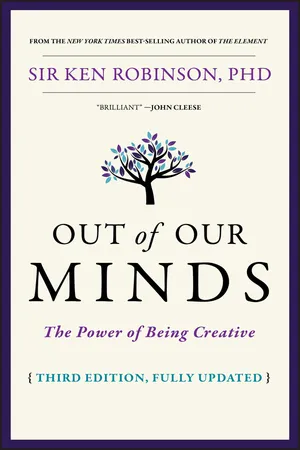
Out of Our Minds
The Power of Being Creative
Ken Robinson
- English
- ePUB (mobile friendly)
- Available on iOS & Android
Out of Our Minds
The Power of Being Creative
Ken Robinson
About This Book
Creativity is critical.
Out of Our Minds explores creativity: its value in business, its ubiquity in children, its perceived absence in many adults and the phenomenon through which it disappears — and offers a groundbreaking approach for getting it back. Author Sir Ken Robinson is an internationally recognised authority on creativity, and his TED talk on the subject is the most watched video in TED's history. In this book, Sir Ken argues that organisations everywhere are struggling to fix a problem that originates in schools and universities. Organisations everywhere are competing in a world that changes in the blink of an eye – they need people who are flexible enough to adapt, and creative enough to find novel solutions to problems old and new. Out of Our Minds describes how schools, businesses and communities can work together to bring creativity out of the closet and realise its inherent value at every stage of life. This new third edition has been updated to reflect changing technologies and demographics, with updated case studies and coverage of recent changes to education.
While education and training are the keys to the future, the key can also be turned the other way; locking people away from their own creativity. Only by actively fostering creativity can businesses unlock those doors and achieve their true potential. This book will help you to:
- Understand the importance of actively promoting creativity and innovation.
- Discover why creativity stagnates somewhere between childhood and adulthood.
- Learn how to re-awaken dormant creativity to help your business achieve more.
- Explore ways in which we can work together to keep creativity alive for everyone.
Modern business absolutely demands creativity of thought and action. We're all creative as children — so where does it go? When do we lose it? Out of Our Minds has the answers, and clear solutions for getting it back.
Frequently asked questions
Information
1
OUT OF OUR MINDS
“When people say to me that they are not creative, I assume that they haven’t yet learnt what is involved.”
CREATING THE FUTURE
- Why is it essential to promote creativity? Business leaders, politicians and educators emphasize the vital importance of promoting creativity and innovation. Why does this matter so much?
- What is the problem? Why do people need help to be creative? Young children are buzzing with ideas. What happens as we grow up to make us think we are not creative?
- What is involved? What is creativity? Is everyone creative or just a select few? Can creativity be developed and, if so, how?
RETHINKING CREATIVITY
“My starting point is that everyone has huge creative capacities as a natural result of being a human being. The challenge is to develop them. A culture of creativity has to involve everybody, not just a select few.”
Special people?
Special activities?
Letting go?
Learning to be creative
THREE THEMES
- We are living in times of revolutionary changeNo matter where you are or what you do, if you live on earth you are caught up in a global revolution. I mean this literally not metaphorically. There are forces at work now for which there are no precedents. Human affairs have always been turbulent. What is distinctive now is the rate and scale of change. Two of the driving forces are technological innovation and population growth. Together they’re transforming how we live and work, changing the nature of politics and culture and putting perilous strains on the earth’s natural resources. The outcomes are unpredictable. What is certain is that we and our children are confronting challenges that are unique in human history.1
- We have to think differently about our talents and abilitiesGiven the challenges we face, the most profound shift has to be in how we think about our abilities and those of our children. In my experience, many people have little idea of their real talents. Too many think they have no special talents at all. My premise is that we are all born with immense talents but that too few people discover or develop them. Ironically, one of the reasons is education. The waste of talent is not deliberate. Most educators have a deep commitment to helping students do their best. Politicians make impassioned speeches about making the most of every student’s abilities. The waste of talent may not be deliberate but it is systemic. Dominant approaches to education and training are preoccupied with certain types of ability that systematically overlook the talents and stifle the creative confidence of untold numbers of people.
- We have to run schools, companies and communities differentlyLeading a culture of innovation has radical implications for how institutions are organized, whether they are schools or corporations, and for styles of leadership. Business and public sector leaders commonly share three perspectives. They know that one of the biggest challenges they face is the increasing complexity of the global environment, which they expect to accelerate in the coming years. They are concerned that their organizations are not equipped to cope with this complexity. They agree that the most important leadership skill for dealing with this growing complexity is creativity. Many organizations put on occasional training days to encourage their staff to think creatively; but, like the rituals of rain dancing, I believe they may misunderstand the problems they’re trying to solve. The problems they face are immediate and there are some immediate things they can do to tackle them, but the long-term solutions lie upstream in the education system.